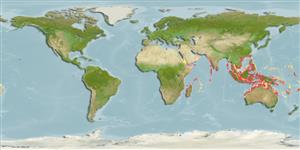Classification / Names
Common names from other countries
Main reference
Size / Weight / Age
Max length : 100.0 cm TL male/unsexed; (Ref. 3678); 84.6 cm TL (female)
Length at first maturity
Lm ?, range 68 - 75 cm
Environment
Marine; reef-associated; depth range 0 - 40 m (Ref. 244)
Climate / Range
Tropical, preferred ?; 24°N - 30°S
Distribution
Indo-West Pacific: reported to occur throughout the area, from Kenya to Indonesia; north to China. Distribution west of the Indo-Malay Peninsual needs validation.
Countries | FAO areas | Ecosystems | Occurrences | Introductions
Short description
A small species which is distinguished by the following characters: snout moderately long and bluntly pointed; upper anterior teeth oblique and blade-like, coarsely serrated laterally, lateral margin deeply notched and with several large and smooth basal cusplets; lower anterior teeth narrower, slightly oblique, lateral margins usually not notched and with several large basal serrae, mostly smooth; total tooth row 24-28/22-27 or 47-55; interdorsal space often without a ridge on midline, 19.0-22.4% TL; first dorsal fin is moderately tall and falcate, origin about opposite pectoral-fin free rear tip, length 14.7-16.0% TL, 1.3-1.7 times height, inner margin 2.1-2.7 in base; second dorsal fin is much smaller, broadly triangular, height 31-37% of first dorsal fin height, its origin slightly posterior to anal-fin origin; anal fin falcate, height 0.9-1.2 times second dorsal height, base 1.0-1.3 times second dorsal-fin base; body colour pale brownish to grey dorsally, whitish ventrally; second dorsal fin with a black blotch covering most of fin and often extending slightly onto upper surface of body, usually diffuse-edged and poorly defined from ground colour of fin; other fins are plain or with pale outer margins; total vertebral 146-163; monospondylous precaudal 42-48; diplospondylous precaudal 26-38; diplospondylous caudal 74-81; precaudal 71-82 (Ref. 89954).
IUCN Red List Status (Ref. 115185)
Human uses
Fisheries: commercial; gamefish: yes
More information
ReferencesAquacultureAquaculture profileStrainsGeneticsAllele frequenciesHeritabilityDiseasesProcessingMass conversion
Tools
Special reports
Download XML
Internet sources
Estimates of some properties based on models
Phylogenetic diversity index
PD50 = 0.5000 many relatives (e.g. carps) 0.5 - 2.0 few relatives (e.g. lungfishes)
Trophic Level
4.2 ±0.4 se; Based on diet studies.
Resilience
Very Low, minimum population doubling time more than 14 years (Fec=1)
Vulnerability
Moderate vulnerability (39 of 100)
Price category
